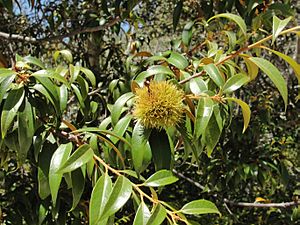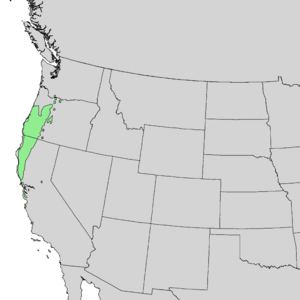Golden chinquapin facts for kids
Quick facts for kids Golden chinquapin |
|
|---|---|
 |
|
| Conservation status | |
| Scientific classification | |
| Genus: |
Chrysolepis
|
| Species: |
chrysophylla
|
 |
|
| Natural range of Chrysolepis chrysophylla | |
| Synonyms | |
|
|
The Golden Chinquapin (scientific name: Chrysolepis chrysophylla) is a cool plant that can be a shrub or a tree. It belongs to the beech family, just like oak trees! People also call it the Giant Chinquapin or Western Chinquapin. You can find this special plant growing along the Pacific coast of the United States.
Contents
Where the Golden Chinquapin Lives
The Golden Chinquapin is a plant that is endemic to a specific area. This means it naturally grows only in one part of the world. For the Golden Chinquapin, that place is the Pacific coast of the United States.
- It grows from the very southern part of Washington state.
- Then it spreads through western Oregon.
- And goes all the way south to west-central California.
This plant likes to live in old, established forests. These forests are often full of tall trees like redwood, white fir, western hemlock, and Shasta red fir. Sometimes, it grows as a smaller plant under these big trees. This is called the understory. Other times, it grows as a large tree right alongside them.
You can find the Golden Chinquapin in different kinds of places. It lives in coastal forests, woodlands, and even chaparral areas. In the western Cascade Mountains, it likes western hemlock forests. If you go to the southern Cascades, you'll find it at higher places. But there, it usually grows as a smaller, bushier plant.
What the Golden Chinquapin Looks Like
The Golden Chinquapin can look very different depending on where it grows. In dry areas, high up in the mountains, or in poor soil, it usually stays a shrub. But in cooler, wetter places, like valley bottoms or foggy areas, it can grow into a huge tree. These trees can reach up to 45 meters (about 148 feet) tall!
The bark of young trees is thin and smooth. As the tree gets older, its bark becomes thicker and looks like plates. A large Golden Chinquapin tree has a cone-shaped top that is quite open. Its leaves are tough and stay green all year round. The top side of the leaves is dark green, but the underside is a beautiful golden color. The leaves are also folded upwards along their middle line.
Reproduction and Life Cycle
The Golden Chinquapin is a monoecious plant. This means that one single plant has both male and female flowers on it. The white male flowers grow where the leaves meet the stem. Below them, you'll find a cluster of female flowers.
After the flowers, a spiky bur grows. Inside this bur, there are usually one to three nuts. These nuts are edible!
At the bottom of the tree, there is often a large, lumpy growth called a burl. New shoots can grow from this burl. This is a way the plant can make copies of itself without needing seeds. It's called vegetative reproduction. This is more common in dry places where it's hard for new seedlings to grow from seeds. A Golden Chinquapin tree can live for a very long time, sometimes up to 500 years!
Uses of the Golden Chinquapin
The wood of the Golden Chinquapin is very heavy and strong. It has a light brown color with a hint of pink. However, this tree doesn't usually grow in large enough groups to be used for big commercial projects. So, you won't often see furniture or buildings made from its wood.
The nuts from the Golden Chinquapin are safe to eat! They taste a bit like hazelnuts or filberts. Many animals love to eat these nuts too. Squirrels and chipmunks especially enjoy them as a tasty snack.


